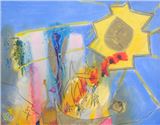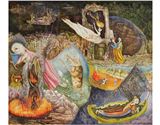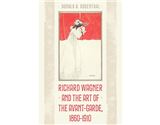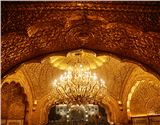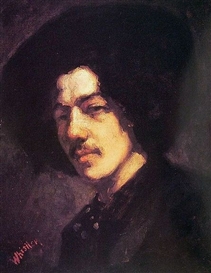Acquainted With the Night: How Whistler’s Nocturnes Changed America
James Abbot McNeill Whistler’s famous series of ‘Nocturnes’ changed America’s vision of itself forever
Adam Heardman / MutualArt
Sep 27, 2022
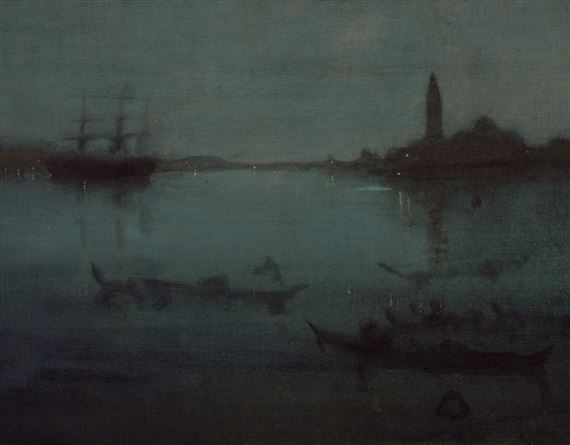
Robert Frost, the poet who is outdone perhaps only by Walt Whitman in terms of his importance to the literary consciousness of the modern United States, once wrote a hymn to nighttime, entitled "Acquainted With the Night." A neat and tightly rendered poem, it reads, in its entirety:
I have been one acquainted with the night.
I have walked out in rain – and back in rain.
I have outwalked the furthest city light.
I have looked down the saddest city lane.
I have passed by the watchman on his beat
And dropped my eyes, unwilling to explain.
I have stood still and stopped the sound of feet
When far away an interrupted cry
Came over houses from another street,
But not to call me back or say good-bye;
And further still at an unearthly height,
One luminary clock against the sky
Proclaimed the time was neither wrong nor right.
I have been one acquainted with the night.
James McNeill Whistler, Nocturne (c.1870-1877)
The dusky atmosphere and the strange mood of the speaker in this poem could be identified as being curiously modern-American. That tension between a city and its outer limits; the weird melancholy of peopled distances; the thwarted impulse towards individuality; confusion between sentimentality and morality, “neither wrong nor right.” But, perhaps most importantly, the elixir-like, intoxicating fascination with night.
This poem appeared in 1928, around 25 years after the death of America’s first great master of the night, James Abbot McNeill Whistler. That such a mood entered and was sustained in the broad American consciousness says much about the vast and profound influence Whistler’s nighttime scenes had upon American art and thought at the turn of the century.
James McNeill Whistler, Nocturne in Blue and Silver, Battersea Reach (c.1870-1875)
It’s perhaps strange that an artist who spent most of his significant working life in Europe was so keenly embraced as a culturally significant American; that a man who delighted in being a curmudgeon, who titled his autobiography The Gentle Art of Making Enemies, should be so broadly loved. But the massy, universal appeal of his paintings, particularly his series of nighttime views, is undeniable. They speak to post-Enlightenment individualism in an age of increasingly globalised enterprise. Of fundamental human truths in the face of new and terrifying powers. Of nostalgia in the face of progress. Their atmosphere is like some qualified impulse of tenderness in an age of alienation – we can’t go as far as to feel "loved," but seeing a faint glimmer of suggested or reflected light over the waters of the Thames, we feel some Gatsby-ish yearning that can’t quite find a formal expression. The hugeness of the statement is in its understatement, its color in its monochrome. No, we’re not quite "loved." But we’re "acquainted."
James Abbot McNeill Whistler painted a series of nighttime views of the Thames at Battersea between 1870 and the mid-1880s. The artist himself saw these nocturnes as a move towards abstraction, a step backwards from the contemporary world into a purely aesthetic zone. Art for art’s sake. “By using the word ‘nocturne,’” Whistler later explained, “I wished to indicate an artistic interest alone, divesting the picture of any outside anecdotal interest which might have been otherwise attached to it. A nocturne is an arrangement of line, form, and color first.”
James McNeill Whistler, Nocturne in Blue and Silver, Chelsea (1871)
His good friend, the novelist Joris-Karl Huysmans, remarked that Whistler’s nocturnes were “far from modern life, far from everything, at the far reaches of painting, which seem to evaporate into invisible puffs of colors on these light canvases.”
And yet, it is significant to our readings of the paintings themselves that they can’t outrun their own anecdotes, and neither can their creator. Whistler, living and painting in London and continental Europe, was not initially considered among significant American painters of the age, until his now-iconic portrait of his mother was bought by the French government in 1891, late in Whistler’s career. This was a very rare accolade for an American artist, and US intellectuals and art lovers accepted him now as one of their own. To such an extent was he taken to America’s heart that Ezra Pound, as the First World War edged closer, exclaimed in a poem addressed to the painter, “You and Abe Lincoln from that mass of dolts / Show us there's chance at least of winning through.”
James McNeill Whistler, Nocturne Blue and Gold, Old Battersea Bridge (1872-1875)
Whistler’s rejection-then-acceptance by the American canon is a double movement that is weirdly reflected in the fact that his paintings, which sought to escape “outside anecdotal interest,” seem to be everywhere followed by inescapably intriguing anecdotes. Not least among these is the lawsuit Whistler brought against influential English critic, John Ruskin. Whistler felt that Ruskin’s harsh criticism of his nocturnes – he famously said, “I have seen, and heard, much of Cockney impudence before now; but never expected to hear a coxcomb ask two hundred guineas for flinging a pot of paint in the public's face” – amounted to libel.
In court, the judge asked Whistler how long it took him to produce the painting in question, Nocturne in Black and Gold, The Falling Rocket (c.1875). “Oh, I knock one off in a couple of days,” Whistler replied. “And the labor of two days is that for which you ask two hundred guineas?” asked the incredulous judge. “No,” came Whistler’s reply, now among the most famous and often-quoted commentaries on modern art: “I ask it for the knowledge I have gained in the work of a lifetime.”
James McNeill Whistler, Nocturne in Black and Gold, The Falling Rocket (c.1875)
Anecdotes attach themselves to Whistler’s nocturnes despite their move away from anecdotalism. This doubleness is in fact further redoubled in the very content of the paintings themselves. By trying to move “far from modern life, far from everything,” they all the more strongly capture the contemporary cloud of human feeling at the end of a long century, and the shivering mix of excitement and fear with which Western humans moved into the modern technological age. Because your vision is veiled at night, it is equal parts "fraught with danger" and "rich with possibility." Whistler understood this deeply.
James McNeill Whistler, Nocturne in Grey and Gold, Westminster Bridge (1871-1874)
And if little circumstantial vignettes attach themselves to these paintings, so does the broad sweep of fin-de-siècle history. In her superb book, Nocturne: Night in American Art, 1890-1917 (2015), Hélène Valance details the ways in which Whistler’s nocturnes captured, or perhaps even created, a burgeoning American obsession with nighttime. The invention and dissemination of electric light made darkness visible, made the night a new and inhabitable frontier. As Americans became acquainted with the night, it began to symbolize that other new frontier, the 20th century. In Valance’s words, “In the late nineteenth century, night, one of the rare phenomena of human experience that seemed truly universal and immutable, entered history.”
Electricity helped discover a zone of universal human experience, the perfect emotional subject for a painter interested in dissolving forms into some absolute statement. And so, by trying to move outside of history, Whistler ended up writing it.
James McNeill Whistler, Nocturne in Blue and Silver, The Lagoon, Venice (1879-1880)
Whistler’s frame steps backward across the water, structures, and human figures and even sources of light become dissolved into a veiled monochrome. He’s at a lonely remove, but like Frost’s speaker hearing voices over rooftops or catching the eye of a night watchman, this vantage point begins to see history and modernity blinking across the water. The light of progress is warm and beautiful from this distance, but not un-foreboding. Whistler feels compelled and repelled at once. Like the reluctance of a newborn being dragged into the world.
In these vistas we have outwalked the furthest city light. Things seem luminary, unearthly. We can’t or are unwilling to explain what it is that we feel, neither wrong nor right but some busily nuanced complexion of each. Forms and figures are obscured by the fog of distance, the mist of our own breath before us. We’re alone but curiously united, fading into the abstracts of the dark, but somehow more firmly ourselves than ever before. Whistler shows us that we’ve all been one acquainted with the night.
For more on auctions, exhibitions, and current trends, visit our Magazine Page


